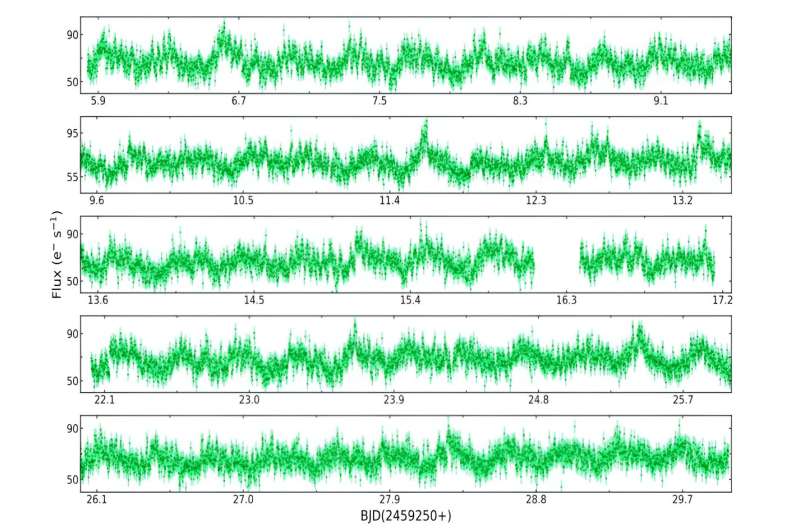August 1, 2023 report
This article has been reviewed according to Science X's editorial process and policies. Editors have highlighted the following attributes while ensuring the content's credibility:
fact-checked
preprint
trusted source
proofread
Two intermediate polars investigated by astronomers

By analyzing the long-term, high-cadence continuous photometry from NASA's Transiting Exoplanet Survey Satellite (TESS), astronomers have investigated UU Columbae and Swift J0939.7-3224—two intermediate polars. Results of the study, presented July 24 on the preprint server arXiv, yield important insights into the properties of these two systems.
Cataclysmic variables (CVs) are binary star systems consisting of a white dwarf accreting material from a normal star companion. They irregularly increase in brightness by a large factor, then drop back down to a quiescent state. Polars are a subclass of cataclysmic variables distinguished from other CVs by the presence of a very strong magnetic field in their white dwarfs.
In some CVs, accretion occurs through a truncated accretion disk when the white dwarf is moderately magnetic. These systems are known as intermediate polars (IPs). Observations have shown that in IPs, the magnetic white dwarf spins asynchronously with the orbital period of the system and therefore produces a rapid oscillation with the spin period. Therefore, determining precise spin period and precise oscillation ephemeris could be the key to reveal the IP nature of some CVs.
UU Columbae, or UU Col for short (discovery name: RX J0512.2-3241) was identified as a soft X-ray intermediate polar in 1996, at a distance of some 8,300 light years. Its orbital and spin periods were measured to be 3.45 hours and 863 seconds, respectively. The system showcases polarized variability, which is most likely due to the cyclotron emission from two poles.
Swift J0939.7-3224, or J0939 for short, is a candidate IP detected in 2015. Previous studies of this source have provisionally suggested that its orbital and spin periods are approximately 8.5 hours and 2,670 seconds, respectively.
Recently, a team of astronomers led by Nikita Rawat of the Aryabhatta Research Institute of observational sciencES (ARIES) in India, decided to explore UU Col and J0939 with TESS, in order to shed more light on their nature.
The observations UU Col revealed short-term variations superimposed on long-term variability. The collected data allowed the astronomers to revise orbital and spin periods of this IP as 3.46 hours and 863.74 seconds, respectively. The beat period of UU Col was found to be about 928 seconds. The researchers noted that their findings in general indicate that this system is a disk-fed dominated disk-overflow accretor.
When it comes to J0939, its TESS light curve showcases a clear variability pattern. The orbital and spin periods were refined as 8.49 hours and 2671.8 seconds, respectively. Moreover, the presence of spin period in the TESS power spectrum of J0939 confirmed its IP nature.
The authors of the paper also report the absence of beat frequency in J0939, which suggests that it may be a pure disk-fed accretor. However, X-ray observations of this system are required in order to confirm this assumption.
More information: Nikita Rawat et al, A preliminary timing analysis of two intermediate polars: UU Col and Swift J0939.7-3224, arXiv (2023). DOI: 10.48550/arxiv.2307.12962
Journal information: arXiv
© 2023 Science X Network



















